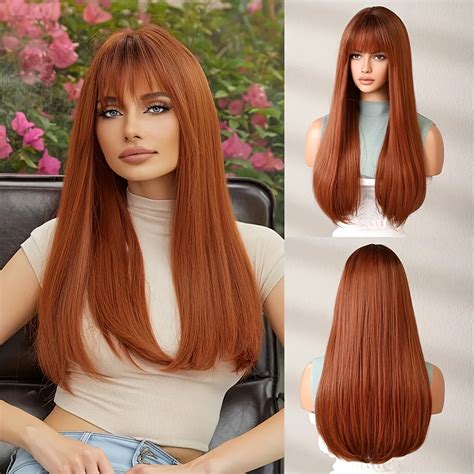There’s a world beyond hair extensions and weaves. Wigs come in various types, each designed to enhance your appearance and fulfill specific needs. From the raw beauty of human hair to the versatility of synthetic strands, let’s explore the types of wigs that transform your style and empower your self-expression.

Human Hair Wigs
Indulge in the luxuriousness of human hair wigs. Their premium quality and natural texture provide unparalleled versatility and style options.
Lace Front Wigs
Lace front wigs offer a natural-looking hairline by utilizing a sheer lace fabric that blends seamlessly with your skin tone. They allow for flexible styling and can be parted and styled as desired.
Pros:
- Natural hairline
- Versatile styling options
- Lasts up to 2 years with proper care
Cons:
- More expensive than synthetic wigs
- Require regular maintenance
Full Lace Wigs
Full lace wigs are the epitome of wig craftsmanship. They are made entirely of lace, providing a natural and undetectable look from all angles. Full lace wigs offer maximum breathing comfort and can be styled in endless ways.
Pros:
- Undetectable hairline
- Most breathable type of wig
- Versatile styling options
Cons:
- Highest price point
- Requires expert installation
360 Lace Wigs
360 lace wigs strike a balance between lace front and full lace wigs. They feature a lace band that extends around the entire perimeter of the wig, providing a natural-looking hairline and versatility while being more affordable than full lace wigs.
Pros:
- Natural hairline from all angles
- More breathable than lace front wigs
- Affordable compared to full lace wigs
Cons:
- Not as versatile as full lace wigs
- Requires some styling effort
Synthetic Wigs
Embrace the convenience and affordability of synthetic wigs. They offer a wide variety of styles, colors, and textures, empowering you to experiment with different looks without breaking the bank.
Lace Front Synthetic Wigs
Lace front synthetic wigs combine the natural-looking hairline of lace front wigs with the affordability and durability of synthetic fibers. They offer a compromise between human hair and full synthetic wigs.
Pros:
- Natural hairline
- More affordable than human hair wigs
- Easy to maintain
Cons:
- Less versatile than human hair wigs
- Shorter lifespan (6-12 months)
Full Synthetic Wigs
Full synthetic wigs are made entirely of synthetic fibers, providing a cost-effective and low-maintenance option. They come in a myriad of styles and colors, perfect for experimenting with different looks.
Pros:
- Affordable
- Easy to maintain
- Versatile styling options
Cons:
- Less natural-looking than human hair wigs
- Not as breathable as lace wigs
Types of Wig Caps
Choosing the right wig cap is crucial for a comfortable and secure fit. Here are the common types:
Glueless Wigs: Use adjustable straps and combs to secure the wig without the need for adhesives.
Glued Wigs: Require adhesive to attach the wig to the scalp, providing a more secure fit.
Lace Wigs: Have a thin lace base that blends with the skin, creating the illusion of a natural hairline.
Closed Wigs: The entire wig cap is covered with hair, providing a fuller and denser look.
Monofilament Wigs: Feature a lightweight and breathable monofilament base that mimics the scalp, providing a more natural look.
Wig Customization
Transform your wig into a bespoke masterpiece that perfectly complements your style and facial features.
Wig Dyeing
Elevate your wig with a vibrant new hue. Human hair wigs can be safely dyed, while synthetic wigs require special dyes.
Wig Cutting
Tailor the wig to your desired shape and length by having it professionally cut and styled.
Wig Bleaching
Lighten the wig’s color to achieve a platinum blonde or ombré look, but note that this process can damage the hair.
Common Mistakes to Avoid
Wearing the Wig Too Tight: Causes discomfort and tension, leading to headaches and hair loss.
Improper Wig Application: Using too much adhesive or applying it incorrectly can damage your scalp and hair.
Lack of Maintenance: Neglecting regular cleaning, brushing, and conditioning can shorten the life of your wig and make it unhygienic.
Forgetting to Trim the Lace: Leaving the lace around the hairline untrimmed can create an unnatural look.
Future Trends in Wig Technology
Prepare for cutting-edge wig innovations that enhance comfort, versatility, and personalization.
- Bio-Compatible Wigs: Wigs made of advanced materials that seamlessly integrate with the scalp, providing an unmatched level of comfort and realism.
- Self-Adjusting Wigs: Wigs equipped with sensors that automatically adjust the fit based on head size and shape, eliminating the need for manual adjustments.
- Smart Wigs: Wigs embedded with technology that allows for remote styling and color changes, empowering users to customize their look on the go.
- Personalized Wigs: Wigs custom-designed using 3D scanning and artificial intelligence, ensuring a perfect fit and style that caters to individual preferences.
Conclusion
Navigating the world of wigs can be overwhelming, but understanding the different types and options available empowers you to make informed decisions. From the luxurious elegance of human hair to the affordability and convenience of synthetic wigs, there’s a wig to suit every need, budget, and style. Embrace the freedom of transformation and let your wig unleash your true self-expression.
